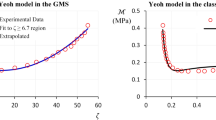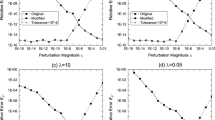Abstract
The experimental determination of a strain energy function W for a rubber specimen must address departures from an elastic ideal in a rational fashion. Herein, such a rational experimental method is developed for biaxial stretching experiments and applied to rubber data in the literature. It is shown that Rivlin's representation formula is experimentally ill-conceived because experimental error is magnified to the extent that error obscures trends in the response function plots. Upon developing direct tensor expressions for the response function calculations, we show that Rivlin's representation formula (or any such constitutive law that has high covariance amongst the response terms) magnifies experimental error greatly. By “high covariance”, we mean the inner product amongst the response terms in the constitutive law is nearly equal to the maximum possible value - i.e., the product of their magnitudes. Moreover, we show that the second partials of W with respect to I 1 and I 2 should approach infinity as the strain decreases. Using an alternate set of invariants with minimal covariance (i.e., a null inner product amongst the response terms), a W for rubber can be determined forthwith.
Similar content being viewed by others
References
R.S. Rivlin, Large elastic deformations of isotropic materials: IV. Further developments of the general theory. Phil. Trans. Roy. Soc. A 241 (1948) 379–397.
R.S. Rivlin and D.W. Saunders, Large elastic deformations of isotropic materials: VII. Experiments on the deformation of rubber. Phil. Trans. Roy. Soc. A 243 (1951) 251–288.
R.S. Rivlin and K.N. Sawyers, The strain-energy function for elastomers. Trans. Soc. Rheol. 20 (1976) 545–557.
M. Mooney, A theory of large elastic deformation. J. Appl. Phys. 11 (1940) 582–592.
A.N. Gent and A.G. Thomas, Forms of the stored (strain) energy function for vulcanized rubber. J. Polym. Sci. 28 (1958) 625–628.
L.J. Hart-Smith, Elasticity parameters for finite deformations of rubber-like materials. Z. Angew. Math. Phys. 17 (1967) 608–626.
H. Alexander, A constitutive relation for rubber-like materials. Internat. J. Engrg. Sci. 6 (1968) 549–563.
Y. Obata, S. Kawabata and H. Kawai, Mechanical properties of natural rubber vulcanizates in finite deformation. J. Polymer Sci. A 2(8) (1970) 903–919.
A.G. James, A. Green and G.M. Simpson, Strain energy function of rubber. I. Characterization of gum vulcanization. J. Appl. Polymer Sci. 19 (1975) 2033–2058.
L.R.G. Treloar, The Physics of Rubber Elasticity. Clarendon Press, Oxford (1975) p. 225.
J.C. Criscione, J.D. Humphrey, A.S. Douglas and W.C. Hunter, An invariant basis for natural strain which yields orthogonal stress response terms in isotropic hyperelasticity. J. Mech. Phys. S. 48 (2000) 2445–2465.
D.F. Jones and L.R.G. Treloar, The properties of rubber in pure homogeneous strain. J. Phys. D: Appl. Phys. 8 (1975) 1285–1304.
Y. Beers, Introduction to the Theory of Error. Addison-Wesley, Reading, MA (1957).
D.W. Haines and W.D. Wilson, Strain-energy density function for rubber-like materials. J. Mech. Phys. S. 27 (1979) 345–360.
R.W. Ogden, Nonlinear Elastic Deformations. Halsted Press, New York (1984).
E. Laine, C. Vallee and D. Fortune, Nonlinear isotropic constitutive laws: Choice of the three invariants, convex potentials and constitutive inequalities. Internat. J. Engrg. Sci. 37 (1999) 1927–1941.
J.C. Criscione, Direct tensor expression for natural strain which yields a fast, accurate approximation. Internat. J. Comp. Struct. 80 (2002) 1895–1905.
Author information
Authors and Affiliations
Rights and permissions
About this article
Cite this article
Criscione, J.C. Rivlin's Representation Formula is Ill-Conceived for the Determination of Response Functions via Biaxial Testing. Journal of Elasticity 70, 129–147 (2003). https://doi.org/10.1023/B:ELAS.0000005586.01024.95
Issue Date:
DOI: https://doi.org/10.1023/B:ELAS.0000005586.01024.95




